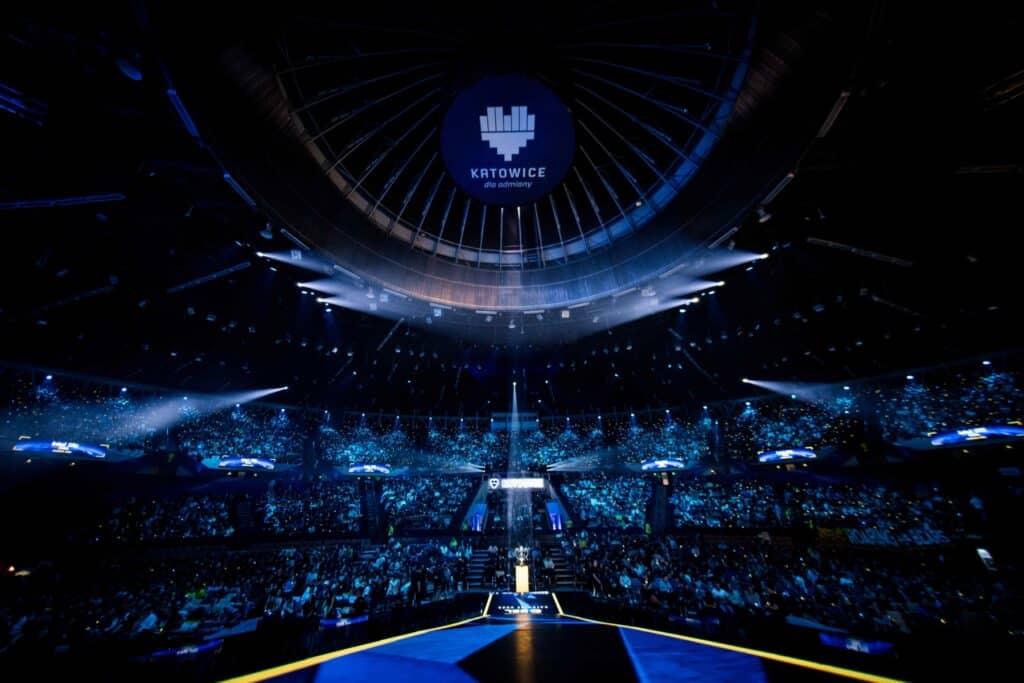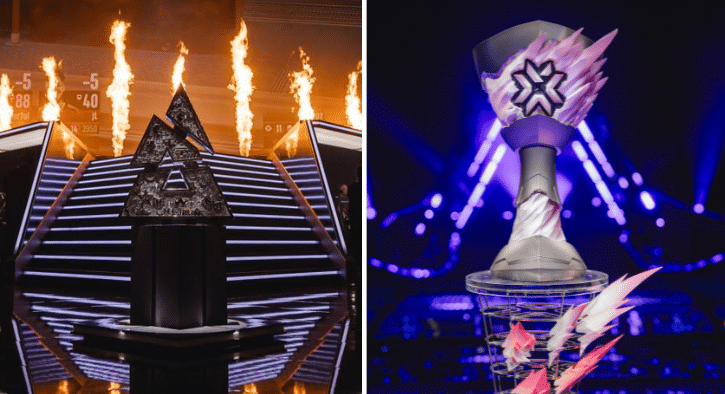Last month, Counter-Strike 2 (CS2) and VALORANT saw two major tournaments overlap for the first time. Both the BLAST.tv Austin Major and Masters Toronto took place in June, even sharing the same Grand Final day on June 22nd.
The similar scale and prize pool of the two events have also reignited comparisons between the FPS titles — one carrying over a decade of legacy and the other still trialing its fairly nascent esports ecosystem.
Two FPS Games, Two Different Ecosystems
As this year’s esports season has passed its halfway point, Esports Insider is delving into the ecosystem, viewership and community of CS2 and VALORANT to determine which game is ahead in 2025 so far.
The CS2 and VALORANT esports scenes follow a fairly different structure, making it difficult to draw direct comparisons. CS2 developer Valve has aimed for an open, competitive ecosystem, allowing organisations of all sizes to qualify for a variety of Tier 1 tournaments organised by major stakeholders in the scene, such as BLAST, PGL and ESL.
Meanwhile, the top-tier VALORANT scene has been running under Riot Games’ franchising model since 2023. This limits the number of teams competing in the regional VALORANT Champions Tour (VCT) leagues, which the game’s publisher itself organises.
In addition to three regional competitions across EMEA, Americas, Pacific and China, the 2025 VALORANT season features three international events. The two Masters iterations in Bangkok and Toronto will be followed by the season-ending Champions tournament.
Finally, the competitive seasons of CS2 and VALORANT are paced quite differently. CS2 sees numerous shorter events throughout the year, whereas the younger esports title prioritises a slower-paced league model, intercepted by its three international highlights.
Counter-Strike 2’s Legacy Still Draws in Millions of Viewers

With all that being said, the recently overlapping Austin Major and Masters Toronto offer a prime opportunity to analyse which tournament FPS fans gravitated to in 2025. Both were Tier 1 international tournaments, reaching the $1m (~£746,000) prize pool mark.
Moreover, both competitions saw their viewership peak during the Grand Final on June 22nd. With nearly 1.8m peak viewers, the Austin Major is notably ahead of Masters Toronto’s 1.12m peak viewership. On top of that, the Austin Major became the most-watched CS2 event in history, recording 76.1m hours watched across its 135-hour airtime.
In comparison, the competition in Toronto was broadcast for 73 hours, garnering 34.8m hours watched. It is, however, noteworthy that the VALORANT event only featured 12 teams compared to Austin’s 32, resulting in fewer matches and airtime.
Interestingly, despite leading in average viewers, Masters Toronto recorded fewer peak viewership than its predecessor in Bangkok (1.3m). But even Bangkok’s numbers cannot keep up with the Austin Major audience.
A similar trend unfolds when you look at the top three tournaments across both games. While CS2’s viewership has grown throughout the year so far, the opposite has been the case for VALORANT. On a regional level, specifically, the season Kickoff events were more popular than VCT Stage 1 following Masters Bangkok. Only Pacific saw an increase in peak viewers between the two regional splits.
| Tournament | Peak Viewers | |
| Counter-Strike 2 | BLAST.tv Austin Major | 1.8m |
| IEM Katowice 2025 | 1.3m | |
| BLAST Rivals Spring 2025 | 1.03m | |
| VALORANT | Masters Bangkok | 1.3m |
| Masters Toronto | 1.1m | |
| VCT Americas Kickoff | 554,000 |
However, the game’s upcoming largest annual tournament, VALORANT Champions in September, has the potential to make new audience records. Similarly, CS2 can still look forward to major competitions, such as IEM Cologne 2025, the Thunderpick World Championship and the StarLadder Budapest Major. For now, CS2 has captured a larger audience in 2025, but there could be an upset.
VALORANT League Structure Affects Prize Money Distribution
Comparing the prize money offered in CS2 and VALORANT esports reveals a similar picture between the two scenes. Throughout 2025, top CS2 teams compete for a variety of prize pools, ranging from $190,000 (~£142,000) to $1.25m (~£933,000). The first half of the year already featured three $1m+ tournaments, with three more to come.
Riot Games, on the other hand, once again focused on VALORANT Champions, which features a $2.25m (~£1.68m) season finale. With the game’s largest prize money injection still ahead, CS2 clearly takes the lead in this category so far.
| Tournament | Prize Pool | |
| Counter-Strike 2 | BLAST.tv Austin Major | $1.25m |
| PGL Cluj-Napoca 2025 | $1.25m | |
| IEM Katowice 2025 | $1m | |
| VALORANT | EWC VALORANT 2025 | $1.25m |
| Masters Toronto | $1m | |
| Masters Bangkok | $500,000 |
Interestingly, both esports titles have established additional revenue streams to ensure teams have access to reliable funding regardless of their competitive performance. Valve and Riot offer revenue-sharing through specific in-game cosmetics. CS2’s logo capsules have long become a fundamental aspect of the game’s ecosystem.
The VCT has also reported several million dollars in revenue generated from digital goods, but Riot’s revenue-sharing model benefits the VCT Partner and Ascension Teams.
VALORANT Meta Sees Regular Additions

In terms of in-game content, Valve’s and Riot’s different approaches to their esports titles become obvious once more. Riot is firmly in charge of regular content updates to shake up the competitive meta while Valve’s laissez-faire attitude allows for a community-driven esports environment.
Following the release of Counter-Strike: Global Offensive replacement CS2 in 2023, Valve has focused on optimising the new title’s gameplay experience. A recent patch in May replaced community maps Basalt, Edin, Palais and Whistle with Agency, Jura and Grail for competitive, casual and deathmatch modes.
However, these new additions are not part of the Active Duty map pool and are, therefore, not played in esports competitions or Premier mode. Instead, Valve reintroduced Overpass and Train to the Active Duty pool, replacing Anubis and Vertigo.
Here is the current CS2 esports map pool:
- Ancient
- Anubis
- Dust II
- Inferno
- Mirage
- Nuke
- Train
Competitor Riot Games prefers to take advantage of VALORANT’s hero-shooter elements to emphasise adaptability to the game’s ever-changing meta at the highest level of competition. In addition to the recent new map release with Corrode, VALORANT has seen two new agents in the first half of 2025 alone.
Initiator Tejo and duelist agent Waylay were released in January and March, respectively. Tejo, in particular, defined the pro play throughout VCT Kickoff and Stage 1 until he received a crushing nerf in Patch 10.09. At least for now, it seems like Riot has learned from the strenuous Chamber meta in 2021/22, whose prolonged domination significantly affected gameplay and esports viewing experiences.
VALORANT also likes to shake up its competitive map pool regularly, with four map rotation updates in 2025 so far. Although the next changes have already been leaked, VCT teams currently compete on the Patch 11.00 rotation:
- Ascent
- Bind
- Corrode
- Haven
- Icebox
- Lotus
- Sunset
VALORANT is a clear winner when it comes to fresh content and shaking up esports content for pros and viewers alike. However, Counter-Strike 2 has managed to garner more viewership in 2025 while maintaining the same map pool and not providing new metas to latch onto.
Considering CS2’s massive audience, numerous big events and prize pools, the veteran FPS title is ahead in 2025 so far. Newcomer VALORANT is unlikely to catch up with the scale of CS2’s esports ecosystem in the near future, but its season-ending Champions tournament might still make viewership records.
The post Counter-Strike 2 vs. VALORANT: Which esport is ahead in 2025? appeared first on Esports Insider.

